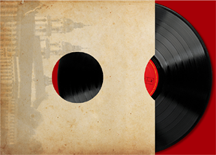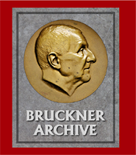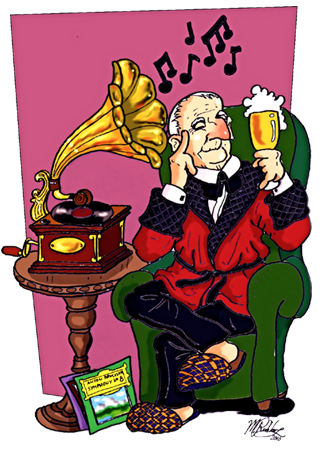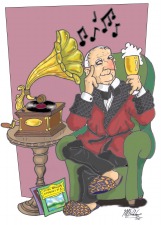A Participant's View: A Report by Sol Siegel
A report by Sol L. Siegel The second East Coast Brucknerathon (Fri.-Sat., 10-11 Sept. 2010) seemed less about the recordings themselves than about a communal experience. Part of this was because John Berky, busy with other projects, left the programming to his Texas friend John Proffitt, resulting in a list that was mostly excellent but perhaps less adventurous than last year's initial event. In fact, I used the day partly as an opportunity to audition some recording I'd been curious about for myself. In any event, after a Friday dinner in a Windsor, CT restaurant (with Takashi Asahina conducting Bruckner on a video screen in the back), we regrouped early Saturday at the Simsbury home of Ken Jacobson and positioned ourselves in front of his superb high-end surround stereo system for music, refreshment (of course there was beer) and camaraderie. The music: Symphony in F minor, a.k.a. "Study-Symphony" (1863): Rupert Frieberger; Orchester Extempore der Internationalen Schlaeger Musikseminare (1997). When the memo went out that this was a derivative student work, someone apparently forgot to cc Maestro Frieberger. This is a performance on a grand scale, fully confident and without a trace of apology, and recorded in a boomy acoustic that puts an exclamation point on everything. A great way to start the morning. Symphony No. 1 in C minor (1877 "Linz"/Ed. Nowak): Eugen Jochum; Berlin Philharmonic (DG, 1965). "Is there anyone here who doesn't know this recording?" I asked rhetorically. It was, in fact, the starting point of a Bruckner love affair for a least one attendee. No comment on this classic should be necessary, except that the 45-year-old recording came up golden on Ken's sound system, making it easier to pick out the Wagner references. Symphony in D minor, a.k.a. "Die Nullte" or "No. 0" (1869): Daniel Barenboim; Chicago Symphony Orchestra (DG, 1979). I had forgotten how good a performance this was and how well the CSO played under Barenboim. John commented that in fact he thought it sounded like a great European orchestra here. Too bad he didn't include the work in his Berlin cycle though some would have it that perhaps it was for the better. (Bill Carragan noted that some parts he unearthed for the 2nd were marked "Symphonie Nr. 3" indicating that Bruckner was considering calling this work "No. 2" as late as 1872.) Symphony No. 2 in C minor (1872 "First Concept" / Ed. Carragan): Simone Young; Hamburg Symphony Orchestra (Oehms SACD, 2006). Carragan supplied us with timed comparison sheets for this one, the comparison being with Tintner's Naxos recording. Young is faster and more excitable in the outer movements, slower and darker in the slow movement, but always offers a strong profile. The problem is that the hall acoustic tends to obscure details, and even melodic lines, in the tuttis, even in surround. At the end someone I don't recall who wondered what Bruckner would have thought of a woman conducting his symphony this well. Someone else countered that he probably would have proposed. Symphony No. 3 in D minor (1873 Original Version / Ed. Nowak): Jonathan Nott; Bamberg Symphony Orchestra (Tudor SACD; 2002). This is the most confident rendition of the 1873 score I've yet heard. John obviously has a taste for those who can project Bruckner's early thoughts without condescension, and in this case with utter fearlessness. The silences in the opening movement were as imposing as fanfares, and as for the finale well, John warned us, "This is going to be wild". The gear changes were done without missing a beat or a hairpin curve. Glorious. Symphony No. 4 in E-flat (1889 Version / Ed. Korstvedt): Osmo Vanska; Minnesota Orchestra (BIS SACD; 2009). Others with ears and knowledge more expert than mine will have more to say about this fine new recording. My own impression was that except for the scherzo, Bruckner's final thoughts on this symphony were as worthy of the repertory as any. I liked the little switch from strings to woodwinds at the start of the slow movement, for example, and the closing peroration, which expands on the horn call added for the Nowak, is certainly satisfying. (Ben Korstvedt said plainly that part of Bruckner's purpose was to make the work more effective in performance.) What makes the scherzo potentially controversial is the fadeout in its first playing and the cut in the da capo both Haydnesque jokes that seem to make this edition play better to those who already knew the score. But that's just my impression. Bill Carragan admired the tempo adjustments in the finale but thought them just a bit more calculated than inspired. Symphony No. 5 in B-flat (1878 Nowak Ed.): Peter Jan Marthe; European Philharmonic Orchestra (Preiser, 2007). This is the least controversial of Marthe's "reloaded" Bruckner recordings with a fine youth orchestra, live at St. Florian. Its main eccentricities are the inclusion of a few of Schalk's cymbal crashes an effective on in the Adagio and two less effective ones in the finale and slow overall tempi. (This was nearly 20 minutes longer than last year's 5th, by Rogner.) Overall, this is a fine performance, with one of the most profound slow movements on record. My big problem was the slowdown in the coda of the finale, which was taken at a tempo broad enough that it really wasn't necessary. Symphony No. 6 in A (1881 Nowak Ed.): Rafael Kubelik; Chicago Symphony Orchestra (CSO; 1982). Bill Carragan simply called this the finest performance of this symphony ever recorded. I won't bore you with details: everything in this rendition is just plain right. The closest thing to a distraction from Bruckner's musical thought was to notice the acoustic Orchestra Hall in the 1980's, which is far from ideal. Even so, it was a bit of a relief in a way, since most of the previous recordings had come from such reverberant halls that I was starting to wonder if Ken's speakers were coloring them that way. No such worries. Symphony No. 7 in E (1885 Nowak Ed.): Paavo Jarvi; Frankfurt Radio Symphony Orchestra (RCA/BMG SACD; 2006). The best recorded sound of the day, full of presence, richness and bloom. This may bewilder those (including the reviewer for the latest issue of Fanfare, which was on the coffee table), who only auditioned the CD layer and found it cold and dead. The performance? I would have been happy to encounter it in the concert hall, especially the finely gauged Adagio. But, to paraphrase Gertrude Stein, there didn't seem to be enough "there" there. Symphony No. 8 in C minor: Ken-Ichiro Kabayashi; Japan Philharmonic Orchestra (Exton DVD; 2003). After dinner (salad, lasagna and Brucknerathon cake) came the day's only video. Now this was a Brucknerathon performance. Kabayashi was totally unknown to me before this, but now I'm a believer. Possessing a fine stick technique his left-hand use makes me think of Sawallisch he leads a fiery 8th that recalls Mravinsky more than Giulini. A huge climax in the opening movement leading to a whispery finish (and no symphony of four slow movements, thank you), and an ennobling Adagio were highlights of a rendition that defied logic surely I should have been too tired to appreciate it by now. But I wasn't. I didn't cite an edition because Kabayashi seemed to flit between Nowak and Haas virtually at will. Somehow I doubt the master would have minded. Symphony No. 9 in D minor, with Carragan completion: Gerd Schaller; Ebrach Festival Orchestra (aircheck; to be released on Profil). The big problem with four-movement Br9s is that the listener automatically references the first three movements to memories of Furtwangler, Walter, Giulini, Jochum, Haitink, Wand, et. al. By that standard, Schaller doesn't do too badly, though the scherzo is far too slow. But most of us were waiting for Bill's latest reworking of the Finale, for which he supplied a bonus: color-coded timed sheets that showed just who wrote what (and to what degree). Bill's remains the strongest of the speculative codas, and afterwards we could debate whether what remains to Bruckner's grand design actually works as a finale. But by then it was past 11 PM, and time to find our way to our cars (it's pitch dark outside Ken's house at night) and then to our hotels. (I got lost again!) As always, all praise to John Berky for organizing the affair, and to Ken and Ruth Jacobson for hosting it. |







